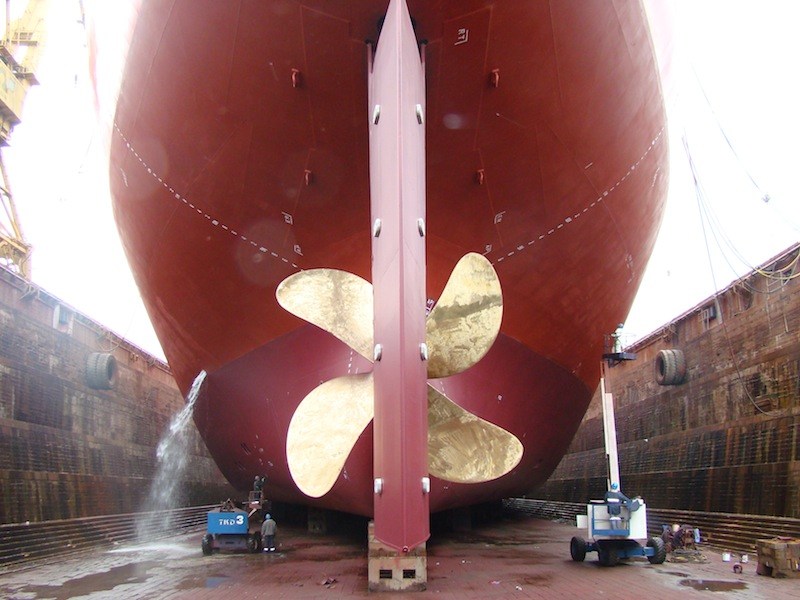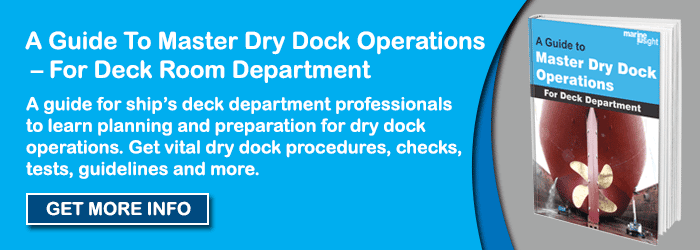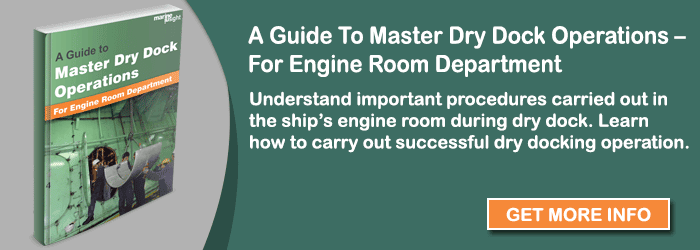Procedure To Take Shore Power During Dry Docking Of Ships
Drydock is one of the most crucial periods for a ship and its staff as it’s the time when all the major repairs and surveys take place. As per the regulations under SOLAS Chapter 1 Regulation 10, a commercial vessel has to undergo two inspections of its hull (outside of the ship’s bottom) in 5 years period conditioning; the time-gap between two of these inspections should not be more than 36 months.
The drydock also gives an excellent opportunity for ship management team to carry out repairs of the main and auxiliary engine, sea water pipes and system, intermediate and tail shaft, propeller, bow thruster and other similar machinery systems whose repairs cannot be performed at high seas when the ship is floating in the water.
Related Read: How to Perform Ship’s Stern Tube Integrity Test in The Dry Dock?

During the drydock, a ship has to take shore power to ensure that the work inside the ship, i.e. in the engine room and deck can be performed uninterrupted.
Related Read: How Cost Estimation is done for Ship’s Dry Dock?
Why ships need shore power?
When the ship sits on the keel blocks in the drydock and the water is removed from the dock to inspect the hull, the auxiliary engine-generators, which produce the electrical power, can no longer work due to non-supply of cooling water to the engine. To avoid overheating of moving parts of the engine, the auxiliary engine has to be switched off before the water is pumped out of the drydock.
Related Read: Dry Docking of Ships – Understanding Stability And Docking Plan
If the ship auxiliary engine and its alternator are included in a major maintenance of the drydock, it needs to be turned off to allow personnel to work on the machine.
The only alternative to shore power is to keep the auxiliary engines running, and that can be done if the shore team provides a separate portable cooling water piping system which can be attached to the inlet and outlet of the ship’s auxiliary engine cooling system. This set up is complex and requires pre-planning. The water provided to the vessel will typically be charged by the quantity (Metric Tonne) supplied to the ship’s system. Hence, shore power supply is preferred over this method.
Related Read: 25 Important Points to Consider While Securing the Engine Room for Dry Docking
Preparation and checks before drydock for receiving shore power:
A chief engineer needs to make sure the ship’s power receiving terminal is prepared well in advance of the drydock so that it can be connected to the shore power without any trouble.
Normally, the ship’s electrical engineer will prepare the ship’s power receiving terminal box and should do following things:
- Ensure the receiving box is not obstructed with any object, pipes or spares. It is usually located either on the deck near accommodation entrance or the emergency generator room
- If the box is not used or maintained for long, clean the box and ensure the safety door hinges and locks are functioning smoothly
- Ensure all the receiving terminals inside the box are present and in good working condition
- Ensure earthing cable is provided to earth the ship’s hull to shore earth
- Ensure measuring instrument such as voltmeter, phase sequence indicator, and tester etc. are present
- Ensure the indication of shore power (in the form of light bulb) is present and working
- Ensure a safety device (circuit breaker or fuse) is provided in the terminal to protect the MSB of the ship
- Ensure details of shore power requirement is pasted near the shore receiving terminal box, which includes required voltage, frequency, and method of connecting the shore supply
- Ensure the ship’s batteries are tested for full charging
Preparation and checks in the drydock before taking shore supply-
The process of receiving shore supply to ship is critical as unprotected connection may lead to accidents and wrong shore supply will hurt the efficiency and increase heat generation from onboard equipment.
Related Read: What is Alternate Marine Power (AMP) or Cold Ironing?
Following things to be checked before connecting shore supply to ship in a drydock:
- Check the cable drawn to ship for providing shore supply is in excellent condition
- Check the insulation resistance of the cable provided for the shore supply
- Check the insulation resistance of the shore supply box
- Check the polarity of shore supply using a voltmeter
- Check and ensure the frequency and voltage of shore supply are matching with the specifications required by the ship
Related Read: How The Power Requirement Of A Ship Is Estimated?
- Check the phase sequence of the shore supply using phase sequence tester
- Check the tightness of the shore cable connector clamp to ensure they are not loose
- Ensure to display notice near the vicinity of ship’s receiving terminal box about high power cable in use
- Check and ensure the ship’s generators are disconnected from the Main Switch Board of the ship
- A responsible officer must check and record the energy meter reading provided on shoreside
- Ensure ship’s hull is earthed to the shore before supplying shore power to the ship
Related Read: How to Minimize the Risks of an Electrical Shock on a Ship?
Taking the Shore Supply-
Once all checks are performed by ship’s engineer and the ship is ready to take the shore power, take the following steps:
- Once the shore supply power is made available to the vessel, the light indicator provided in the terminal box will be ON
- Close the breaker to start the supply of the shore power to ship
Related Read: What are the Main Safety Devices for Main Switch Board on Ship?
- For checking the phase sequence, a bulb type phase sequence indicator can be used in which two lamps are connected to unbalanced load across the 3 phase via capacitor and resistors. The phase sequence will be considered “OK” when the right side lamp is bright, and the left side one is dark
- Another instrument used to measure PSI is a small portable 3 phase induction motor driven meter with a rotary pointer
- Check the frequency of the supply from the provided frequency meter or on the Main Switch Board of the ship
- Ensure to keep the emergency generator in manual mode to use the same if the shore power goes off abruptly and electricity supply is needed
Common problem faced by ship’s staff while taking shore supply-
1. Shore supply switched on, but the ship is not getting power
- Check the three fuses connected between the ship’s terminal and Main Switch Board (MSB)
- Check the circuit breaker located in shore supply switchboard
- Check circuit breaker interlocks which are arranged in the system to avoid paralleling of shore and generator power
2. Shore power trips during supply
- Faulty shore cable. Ensure the cables used for supplying power is of proper size and as per the maximum protective current value of the ship.
- Overload in the system. Ensure to correctly calculate the electrical load of the ship during the drydock using electric power balance table to avoid overload trip.
Generator circuit breaker trip: It is possible that the safety breaker for the generator trips the shore supply during the inspection or maintenance of generator’s interlock.
Related Read: Blackout Situation on a Ship: What are the First Steps that should be Taken?
3. Wrong shore supply
Most countries have their local regulations which make the shore supply compulsory to avoid emission problems. If the voltage and frequency of shore power do not match with the ship’s rating, the machinery will operate at lower efficiency and may face overheating problems. The ship manager must ensure to choose a drydock, which can provide shore supply as per the ship’s requirement.
Related Read: 10 Technologies/Methods for Controlling NOx & SOx Emissions from Ships
* Sensitive electronic equipment such as controllers, navigation equipment etc. are prone to damage from power fluctuation. Try to switch off these systems while the using shore supply. If the equipment needs to be switched on, it is recommended to use battery supply for their operation
Disclaimer :
The information contained in this website is for general information purposes only. While we endeavour to keep the information up to date and correct, we make no representations or warranties of any kind, express or implied, about the completeness, accuracy, reliability, suitability or availability with respect to the website or the information, products, services, or related graphics contained on the website for any purpose. Any reliance you place on such information is therefore strictly at your own risk.
In no event will we be liable for any loss or damage including without limitation, indirect or consequential loss or damage, or any loss or damage whatsoever arising from loss of data or profits arising out of, or in connection with, the use of this website.
Do you have info to share with us ? Suggest a correction
Disclaimer :
The information contained in this website is for general information purposes only. While we endeavour to keep the information up to date and correct, we make no representations or warranties of any kind, express or implied, about the completeness, accuracy, reliability, suitability or availability with respect to the website or the information, products, services, or related graphics contained on the website for any purpose. Any reliance you place on such information is therefore strictly at your own risk.
In no event will we be liable for any loss or damage including without limitation, indirect or consequential loss or damage, or any loss or damage whatsoever arising from loss of data or profits arising out of, or in connection with, the use of this website.

About Author
An ardent sailor and a techie, Anish Wankhede has voyaged on a number of ships as a marine engineer officer. He loves multitasking, networking, and troubleshooting. He is the one behind the unique creativity and aesthetics at Marine Insight.
Latest Marine Technology Articles You Would Like:
- 10 Harmful Effects Of Impure Air On Ship’s Machinery
- 10 Important Things to Check While Starting Fuel Oil Purifier on Ships
- 10 Noteworthy LNG-Powered Vessels
- 10 Points for Efficient Turbocharger Operation On Ships
- 10 Practical Tips to Handle Engine Room Pumps
- 10 Precautions to Take Before Operating Controllable Pitch Propeller (CPP) on Ships
Subscribe To Our Newsletters
By subscribing, you agree to our Privacy Policy and may receive occasional deal communications; you can unsubscribe anytime.



















Good day!
Thank you so much for this article. May I ask for permission to copy this for future referral.